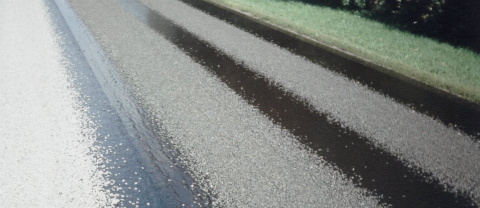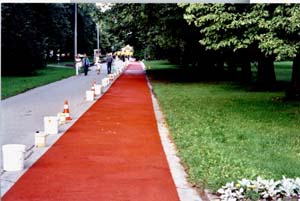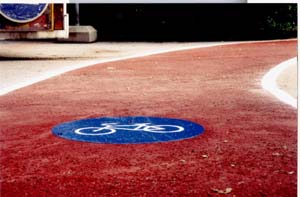1- Single-layer surfacing
Traditional singl-layer surface dressing: one layer of binder and one layer of aggregate.
Recommended for use in places where the structure of the existing covering has been damaged and the cross-section is more or less the same.
Mostly used on roads with light and medium traffic volumes. Suitable where a strong sub-base is in place.
Advantages:
1) easy to do;
2) the cheapest surface dressing technology.
1¼-time surface dressing
An exceptional version of the single-layer surface dressing. A coarser layer (12/16 or 8/12) is spreaded in the wheel tracks, and a finer layer (8/12, 4/8 or 2/4) is spreaded over the rest of the area.

Recommended for use in places where the structure of the covering has been considerably worn out or deformed in wheel ruts, but between the wheel ruts it is sufficient to maintain the covering by pinning the old surface treatment gravel with finer gravel.
Advantages:
1) improves the cross-profile;
2) creates a wearing course exactly where it is needed;
3) saves money on the amount of binder used elsewhere;
4) it is possible to carry out a single-layer surface dressing in wheel ruts, if necessary, by spreading a finer layer across their entire width.
1½-time surface dressing
Two different fractions of aggregate over the width of the entire road, a coarser one (12/16 or 8/12) underneath and a finer one (2/4 or 4/8) on top of it, which wedges the coarser layer.
Recommended for use on roads with heavier traffic volumes, or in certain locations (for urban traffic, at crossroads, on dangerous bends, etc).
Advantages:
1) fastens the stones to each other more securely;
2) decreases loosening of the coarser layer;
3) better contact between the coarser layer and binder;
4) decreases noise levels.
Double-layer surface dressing
A traditional type of surface dressing where two layers of aggregate 12/16 and 4/8 or various other layer thicknesses are bound together with two binder layers.
Recommended for use in the case of softer sub-bases and deformed sub-bases, or where heavy traffic is the norm.
Advantages:
1) wedging is even stronger than for the previous method thanks to the additional layer of a binder;
2) better resistance from the surface dressing, with a longer lifetime.
2½-time surface treatment I
A thicker and stronger surface layer occurs where the base is repaired by wedging it with 12/16 and 4/8 gravel, and a third layer of 8/12 or 4/8 the surface as the required wearing course.
Recommended for use in the surface treatment of very deformed, dust-free hard surfaces.
Advantages:
1) the entire structure is generally much more strong;
2) separate wearing course on the upper layer;
3) longer lifetime in comparison to other technologies.
4) also in comparison with other technologies, the noise levels decrease;
2½ -time surface treatment II
Similar to the previous option, but with a aggregate layer of 12/16 being spreaded on the base first and then wedging it with a binder and a fine aggregate layer of 4/8. It is coated with the required wearing course of 8/12 or 4/8.
Recommended for use for making soft gravel roads dust-free.
The advantage is the creation of a gravel pad before the first binding layer is spreaded. When using other methods for dealing with soft, dusty sub-bases, the binder does not stick to the sub-base due to that dust, and the wheels of heavy vehicles roll up the binder layer together with the gravel. Therefore, aggregate is spreaded as a first layer in order to avoid such situations.
Sandwich surfacing
A aggregate pad of 12/16 or 8/12 is established underneath, which is wedged by a binder layer and a finer aggregate layer of 4/8 or 2/4.
Recommended for use where soft uneven dust-free pavements are found. Also suitable for surface dressing on “bleeding” roads.
Advantages:
1) simple structure;
2) avoids the risk of machinery sinking into the sub-base while the work is being carried out;
3) decreases the penetration of old pot-holes from the surface dressing layer.
Sand surface dressing
A thin bituminous emulsion layer is covered with a sand layer.
Recommended for use in making micro-cracks in the asphalt waterproof. Creates a thin protective layer preventing the penetration of water into the road pavement.
Advantages:
1) small amounts of binder used;
2) easy, fast to complete;
3) can be laid in late autumn, before the winter and snow.
Patch surface dressing
A general single-layer surface dressing to cover single defects (cracks, or weathering) in the road pavement.
In patch surface dressing, we use the HP 27 special surface dressing unit from the Swedish company, Savalco, which allows the width of the treated surface to be selected with an interval of 30cm.
Advantages:
1) the lifetime of the covering can be prolonged by mending any deformed spots;
2) cheaper than a complete surface treatment on the covering;
3) fast and operative work.
“Slurry” overlayer
A thin overlap of different colours meant for distinguishing parking spaces, cycle paths, and various road sections.
The sprayed mixture is in a thin layer (of between 3-5mm) and consists of a aggregate (between 0-3mm), plus filler, the appropriate colour pigment (red, yellow, green, blue, or black), polymer modified bituminous emulsion, and water.

The mixture is environmentally friendly and is laid cold. The work can be carried out wherever the average air temperature is aver 10˚C in a a twenty-four hour period, and the surface is dry. The usual formation period for the layed mix is between 0,5-2 hours. For a smoother structure, the poured covering is rolled with a light roller.

Advantages:
1) better coarseness in comparison with concrete, and asphalt covering
2) new, thin wearing course
3) traffic safety, with the coloured sections being better observed by drivers
“Fogseal” surface dressing
This treatment is useful for asphalt concrete that tends to crack, or for older pavements. The surface is covered by a light application of bituminous emulsion and, if necessary, covered either by filler or sand spreading. A thin, waterproof, fresh bitumenemulsion layer is sprayed on the aging pavement. This is suitable for pavements where it is not necessary to repair the course that is wearing or the friction coefficient, but it is necessary to add bitumen to the pavement.
